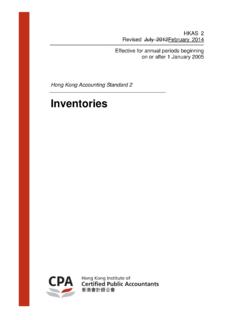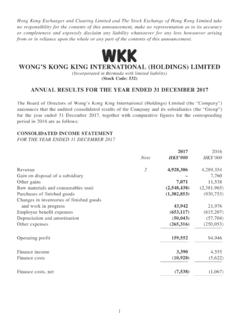Transcription of HKAS 36 Impairment of Assets1 - Nelson CPA
1 HKAS 36 Impairment of Assets1 . Nelson Lam 1. Objective of HKAS 36. The objective of HKAS 36 Impairment of Assets is to prescribe the procedures that an entity applies to ensure that its assets are carried at no more than their recoverable amount. The recoverable amount of an asset or a cash-generating unit is the higher of its fair value less costs to sell and its value in use. (HKAS 36 para. 6). An asset is carried at more than its recoverable amount if its carrying amount exceeds the amount to be recovered through use or sale of the asset. If this is the case, the asset is described as impaired and HKAS 36. requires the entity to recognise an Impairment loss. Carrying amount is the amount at which an asset is recognised after deducting any accumulated depreciation (amortisation) and accumulated Impairment losses thereon. An Impairment loss is the amount by which the carrying amount of an asset (or a cash-generating unit).
2 Exceeds its recoverable amount. (HKAS 36 para. 6). HKAS 36 also specifies when an entity should reverse an Impairment loss and prescribes disclosures. 2. Scope of HKAS 36. HKAS 36 shall be applied in accounting for the Impairment of all assets, other than: (a) inventories (see HKAS 2 Inventories);. (b) assets arising from construction contracts (see HKAS 11 Construction Contracts);. (c) deferred tax assets (see HKAS 12 Income Taxes);. (d) assets arising from employee benefits (see HKAS 19 Employee Benefits);. (e) financial assets that are within the scope of HKAS 39 Financial Instruments: Recognition and Measurement;. (f) investment property that is measured at fair value (see HKAS 40 Investment Property);. (g) biological assets related to agricultural activity that are measured at fair value less estimated point- of-sale costs (see HKAS 41 Agriculture).
3 (h) deferred acquisition costs, and intangible assets, arising from an insurer's contractual rights under insurance contracts within the scope of HKFRS 4 Insurance Contracts; and (i) non-current assets (or disposal groups) classified as held for sale in accordance with HKFRS 5 Non- current Assets Held for Sale and Discontinued Operations. (HKAS 36 para. 1)2. HKAS 36 applies to financial assets classified as: (a) subsidiaries, as defined in HKAS 27 Consolidated and Separate Financial Statements;. (b) associates, as defined in HKAS 28 Investments in Associates; and 1. This note is sourced from HKAS 36 Impairment of Assets. While the note is aimed at covering all critical points of HKAS 36, a complete and comprehensive coverage should still be the original standard, HKAS 36. 2. All the paragraphs in the HKAS have equal authority now. While certain paragraphs in HKAS are highlighted in bold and italic, the same format is adopted in this note for those paragraphs.
4 April 2005 Page 1 of 19. (c) joint ventures, as defined in HKAS 31 Interests in Joint Ventures. For Impairment of other financial assets, refer to HKAS 39. 3. Identifying an Asset that may be Impaired Annual assessment on any indication that an asset may be impaired An entity shall assess at each reporting date whether there is any indication that an asset may be impaired. If any such indication exists, the entity shall estimate the recoverable amount of the asset. (HKAS 36 para. 9). Test for Impairment on intangible asset and goodwill Irrespective of whether there is any indication of Impairment , an entity shall also: (a) test an intangible asset with an indefinite useful life or an intangible asset not yet available for use for Impairment annually by comparing its carrying amount with its recoverable amount. This Impairment test may be performed at any time during an annual period, provided it is performed at the same time every year.
5 Different intangible assets may be tested for Impairment at different times. However, if such an intangible asset was initially recognised during the current annual period, that intangible asset shall be tested for Impairment before the end of the current annual period. (b) test goodwill acquired in a business combination for Impairment annually in accordance with paragraphs 80-99 of HKAS 36 (see section ). (HKAS 36 para. 10). The ability of an intangible asset to generate sufficient future economic benefits to recover its carrying amount is usually subject to greater uncertainty before the asset is available for use than after it is available for use. Therefore, HKAS 36 requires an entity to test for Impairment , at least annually, the carrying amount of an intangible asset that is not yet available for use. Indications that an asset may be impaired In assessing whether there is any indication that an asset may be impaired, an entity shall consider, as a minimum, the following indications: External sources of information (a) during the period, an asset's market value has declined significantly more than would be expected as a result of the passage of time or normal use.
6 (b) significant changes with an adverse effect on the entity have taken place during the period, or will take place in the near future, in the technological, market, economic or legal environment in which the entity operates or in the market to which an asset is dedicated. (c) market interest rates or other market rates of return on investments have increased during the period, and those increases are likely to affect the discount rate used in calculating an asset's value in use and decrease the asset's recoverable amount materially. (d) the carrying amount of the net assets of the entity is more than its market capitalisation. Internal sources of information (e) evidence is available of obsolescence or physical damage of an asset. (f) significant changes with an adverse effect on the entity have taken place during the period, or are expected to take place in the near future, in the extent to which, or manner in which, an asset is used or is expected to be used.
7 These changes include the asset becoming idle, plans to discontinue or restructure the operation to which an asset belongs, plans to dispose of an asset before the previously expected date, and reassessing the useful life of an asset as finite rather than indefinite. April 2005 Page 2 of 19. (g) evidence is available from internal reporting that indicates that the economic performance of an asset is, or will be, worse than expected. (HKAS 36 para. 12). The above list is not exhaustive and an entity may identify other indications. 4. Measuring Recoverable Amount HKAS 36 defines recoverable amount as the higher of an asset's or cash-generating unit's fair value less costs to sell and its value in use. The requirements below for measuring recoverable amount use the term an asset' but apply equally to an individual asset or a cash-generating unit. Recoverable amount is determined for an individual asset, unless the asset does not generate cash inflows that are largely independent of those from other assets or groups of assets.
8 If this is the case, recoverable amount is determined for the cash-generating unit to which the asset belongs (see section 6 below). In some cases, estimates, averages and computational short cuts may provide reasonable approximations of the detailed computations illustrated in HKAS 36 for determining fair value less costs to sell or value in use. Measuring the Recoverable Amount of an Intangible Asset with an Indefinite Useful Life As set out section above, HKAS 36 requires an intangible asset with an indefinite useful life to be tested for Impairment annually by comparing its carrying amount with its recoverable amount, irrespective of whether there is any indication that it may be impaired. However, the most recent detailed calculation of such an asset's recoverable amount made in a preceding period may be used in the Impairment test for that asset in the current period, provided that certain criteria set out in HKAS 36.
9 Are met. Fair Value less Costs to Sell Fair value less costs to sell is the amount obtainable from the sale of an asset or cash-generating unit in an arm's length transaction between knowledgeable, willing parties, less the costs of disposal. (HKAS 36 para. 6). Costs of disposal are incremental costs directly attributable to the disposal of an asset or cash- generating unit, excluding finance costs and income tax expense. (HKAS 36 para. 6). The best evidence of an asset's fair value less costs to sell is a price in a binding sale agreement in an arm's length transaction, adjusted for incremental costs that would be directly attributable to the disposal of the asset. If there is no binding sale agreement but an asset is traded in an active market, fair value less costs to sell is the asset's market price less the costs of disposal. No binding agreement and active market If there is no binding sale agreement or active market for an asset, fair value less costs to sell is based on the best information available to reflect the amount that an entity could obtain, at the balance sheet date, from the disposal of the asset in an arm's length transaction between knowledgeable, willing parties, after deducting the costs of disposal.
10 Costs of disposal Costs of disposal, other than those that have been recognised as liabilities, are deducted in determining fair value less costs to sell. Examples of such costs are legal costs, stamp duty and similar transaction taxes, costs of removing the asset, and direct incremental costs to bring an asset into condition for its sale. However, termination benefits (as defined in HKAS 19. Employee Benefits) and costs associated with reducing or reorganising a business following the disposal of an asset are not direct incremental costs to dispose of the asset. Sometimes, the disposal of an asset would require the buyer to assume a liability and only a single fair value less costs to sell is available for both the asset and the liability. April 2005 Page 3 of 19. Value in Use Value in use is the present value of the future cash flows expected to be derived from an asset or cash-generating unit.
















